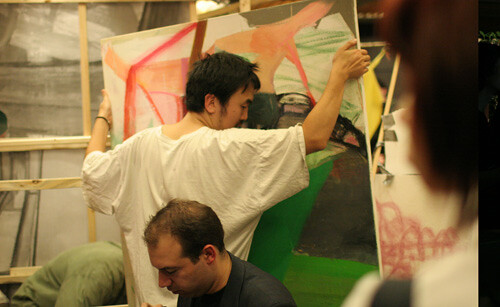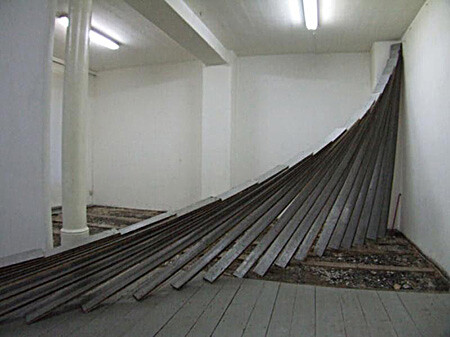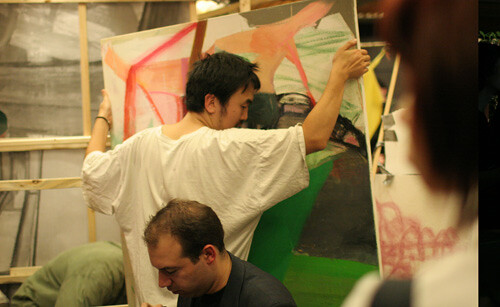Images don’t have to be descriptive; they can be concepts, and Deleuze and I often discuss this point. Concepts are mental images.
—Paul Virilio 1
I am thinking here of a number of divergent works sharing a form of architectural thinking concerned with the potentialities of space. Without suggesting a narrative or illusionary effects, they touch on the virtual by involving everyday material from nearby social and cultural locations in the creation of a moment of suspension—one that can translate into spoken words, installations, staged discourse, drawing, and so forth. In a digital age, this approach to the virtual often assumes an analogue form of expression, for instance by substituting video with camera obscura as a means of not only dealing with the analogue image, but also of using minimal means to construct spaces that are handmade and mechanical.
The interventions of New York-based Ei Arakawa, for instance, symbiotically integrate different forms of art until they become unintelligible. His performances often involve the works of other artists (like those of painters Amy Sillman and Nikolas Gambaroff), which are left to oscillate between changing concepts and situations. 2 He solicits the participation of the audience, not to invoke an inherited avant-garde concern with interactivity, but rather to accompany provisory manifestations in his works’ development and changes over time—also as a meditation on destruction, decay, and theatricality. But his works also seem to lead an initial narrativity into stoic abstraction.
Arakawa’s architectural constructions cannot be fully absorbed in terms of their contingent development in time, as forms of narration, nor in terms of the objects they incorporate in space; they may thus be better understood in relation to the virtual, what Gilles Deleuze has described as a presence, which, though situated in proximity to our material reality, has not been actualized.3 Following Henri Bergson, Deleuze regards the possible as a correlative of the real, as that which will transform itself into reality. The possible conforms to the real, like a plan to be materialized in the future; it is understood as no more than a past form of what later became real. In place of this relationship, Deleuze proposes the virtual and the actual; the virtual is real, but has no actuality in the present; the actual has no resemblance to the virtual—it neither limits it nor selects from it.


Another artist who incorporates the virtual as a formative dimension of his works is the Portuguese Carlos Bunga. Preoccupied as Bunga is with construction as a form of recurrent documentation, spaces appear in his works not as discrete entities, but as intervals between, outside, under, or projected onto other structures. Bunga builds installations—often with fragile, perishable materials—which he sometimes later destroys in performances or even before an exhibition opens. What remain for the audience are only the marks of something that could have been. Some of his works display only the emptiness that results from a previously built installation’s complete destruction. But this emptiness also comprises a collection of moments of loss—perspectives, accidents, and gaps of understanding that failed to find their place in the functioning of a project’s construction. His work ranges from huge installations, like the recent Metamorphosis at the Miami Art Museum in 2009/2010, to abstract compositions such as the The Phaidon Atlas of Contemporary World Architecture (2008), in which the reference book has been shredded and displayed as a mass of remains. His drawings and sculptural objects propose a moment just after, without revealing when, where to, or where from. This moment of transition is not a technical mutation, but rather what Bunga calls a “pictorial space” that does not search for completion by itself or within its own logic. Rather, he performs what could be called “documentary alterations” to his own constructions, modifying past forms of his present buildings.


Here it is important to reiterate that the virtuality we experience in Bunga’s or Arakawa’s superimposition of spatial and temporal layers has no direct causal relation to the works’ perceptible construction or unfolding—their positioning in the realm of the actual. Like the works of other artists I deal with here, Bunga’s built ruins can easily be considered in relation to the destruction of representation; but they can also be related to post-conceptualist works acknowledging the impossibility of the image’s disappearance. For Bunga and others, it is not only the modern trauma of the visible that is at issue, but also the more contemporary contamination with the virtual—to which the works’ performativity is key. In the case of Bunga’s works, it is through their performative force—and not through a suggestion of possibility or the possible—that they operate in the realm of the virtual.
Founded in 1954 by Yoshihara Jiro in Osaka, the Japanese group Gutai can be considered to have marked a crucial shift from performance to performativity. In Rossitza Daskalova’s 1997 interview with Gutai artists Yoshio Shirakawa and Masachi Ogura, the artists explain that in Japan it is possible to identify two avant-gardes: the one before the World Wars that was strongly influenced by socialist movements, but had to stay underground due to the Emperor’s occidentalization policies; and a second one in which artists repressed before the wars became active, with the intention of affecting their social environment in direct ways. 4 This shift brought with it an intentional preoccupation with the nature of matter—a confluence of Marxist ideas and genuine spiritualistic consideration of the object that stemmed directly from Japanese culture. Gutai (meaning “concrete”) also represented a very early reaction against abstractionism, and pleaded, a decade before the Nouveau Réalisme and Conceptualism, for the convergence of art and the everyday. According to their manifesto:
Yet what is interesting in this respect is the novel beauty to be found in works of art and architecture of the past which have changed their appearance due to the damage of time or destruction by disasters in the course of the centuries. This is described as the beauty of decay, but is it not perhaps that beauty which material assumes when it is freed from artificial make-up and reveals its original characteristics? … Above all, we had to search for a centrifugal approach, instead of the centripetal one seen in abstract art. In those days we thought, and indeed still do think today, that the most important merits of abstract art lie in the fact that it has opened up the possibility to create a new, subjective shape of space … We tried to combine human creative ability with the characteristics of the material in order to concretize the abstract space … we were overwhelmed by the shape of space still unknown to us, never before seen or experienced … we have struggled to find an original method of creating that space … Sometimes, at first glance, we are compared with and mistaken for Dadaism, and we ourselves fully recognize the achievements of Dadaism. But we think differently, in contrast to Dadaism, our work is the result of investigating the possibilities of calling the material to life. 5
In their exhibitions, the works were almost never attributed to a single artist-author, but were all signed with the Gutai name. Nevertheless, the group’s bond was not formed around a unitary form of expression, but, on the contrary, permitted various approaches without privileging any single one as being more important than any other—a devoted conceptual, non-authorial gesture. It is apparent in their manifesto that performance, as an artist’s act and art form, is not seen as an end in itself, but rather as a means of giving expression to space and matter—considered to be characterized by intrinsic processes in which the human cannot intervene. Gutai explicitly reject parallels between their work and that of Dada, Action Painting, Happenings—approaches to art stressing artists’ subjectivity. While the processes of material decay and transformation that come to the forefront of their work are meant to be conjugated with human agency, they are not taken as an order of the subjective, nor as an immersive space for the audience to experience, but rather as an investigation into the possibilities of making matter active and vivid—in and through the work of art, as a complete dimension in and of itself.


These concerns speak to a potential in artworks that reveals itself through their performativity. Contrary to performance works, which foreground the agency of the artist, performativity departs from the point where the outcome, impact, and influences of a work detach from its author. Dorothea von Hantelmann defines it as follows:
The performativity of a work of art is the reality, which it manifests by the force of its existence at a place, in a situation, by the force of its production, reception, and lasting. Performativity is an allegation, the power to create reality … The performative dimension designates the bounding of art in a reality, which every single work is also generating. 6
From the Gutai interventions to the works of a contemporary artist such as Ei Arakawa, this reality that a work generates can be said to belong paradoxically to a mental dimension; the works are not experienced through their material proximity, but through a work’s conceptual statement, which opens up another dimension of experience. This is, in other words, the virtual. In Deleuzian terms, these works temporarily actualize a world that is real, but has no actuality in the present—the world of the unmanifested potentialities of matter sought by the Gutai Group, whose works are experienced not through physical devices, but through conceptual ones. The experience offered to the audience becomes a mental counterpoint to the visible.
Another Japanese artist, Berlin-based Yukihiro Taguchi, works in a similar way. In his installation Moment, the wood floor panels of a Berlin gallery were removed and used in an installation inside the gallery that changed form daily from a ping-pong table, to a cinema, to a party room with table and chairs, where he threw a closing party. In a second phase of the work, titled Moments—Performatives Spazieren, he integrated the wood panels into Berlin’s public spaces, making a stop-motion video to document the panels becoming a public bench, street furniture, or melting into the environment. In other works, Taguchi reconfigures space by installing and reinstalling objects (in Ordnung, for instance, from 2008), shifting air to another environment (Giftplatz, from 2007), or transforming an architectural environment into a fluid fabric sculpture (Fabric/k, from 2008). Without introducing or removing any element, it is through the interrelated forces of human presence and movements in space that Taguchi’s self-generating processes sculpt his work in time and begin to function in a very concrete way.


A final artist whose work is relevant in this context is Sancho Silva, an artist who uses vision and its cultural determinations to dismantle pre-constructed space. His works are tautological to the point of collapse, with installations consisting of various entrances to a nonexistent work; hidden mechanisms that simultaneously sustain and destroy constructed space; machines or cabins directing vision both onto the city and back into the mechanism itself; and architectonic urban interventions. One can begin to identify a performative dimension in the way his analogue, spare architectonic spaces invoke political, historical, or social systems, but distort their reflections. A subtle interplay of authority between subject and subjected allows his spatial and temporal conjunctions to disappear between various perspectives through the use of camera obscura and other unpredictable real-time viewing mechanisms. For Kunstgriff (2006), Silva constructed a plywood tunnel with eyelets, which allowed a person to see only specific details of works in the museum where the tunnel was placed. By altering institutional architecture to redirect the contemplation of artworks, Silva modifies not only the focus of the viewer, but also the status of the work.


In the sense that these works use the potentialities of space to transpose the work’s expression and reception onto a virtual dimension, they link to problems originating in the Conceptual Art of the 1960s and ‘70s that resulted in the self-annulation of the artwork. Beyond the formal dissolution achieved by Minimalism, the theoretical dissolution favored by Conceptual Art sought to renounce the work as visible form altogether by replacing the physical work with pure Idea, with philosophy. Post-conceptual art responded to this problem of creating an ideal philosophical surrogate for the absent object, by rendering visible those processes through which the artwork would stage its own disappearance, simply by opening a space for those processes to be problematized. In this sense, the fluid, empty spaces of the works mentioned above look to break existing continuities in a way that does not push the work into total disintegration or pure ephemerality.


It is interesting to note that Michael Newman has suggested that works avoiding documentation theoretically manifest a stronger tendency to blend with other domains of knowledge. 7 And it is through the use of documentation that one can begin to discern the contradictory heritage of Conceptual Art. Originally understood to be a medium allowing for the effects of works to be prolonged and actively maintained, documentary materials did not serve to prolong concepts in and of themselves, but rather the forms of documentation became objects in their own right—a system altogether foreign to the logic of the work. Post-conceptual art, in contrast, employed documentation as discrete works, without renouncing its function. According to Newman, this response constitutes a symptom of the crisis caused by the contradictions embedded within Conceptual Art’s own logic.
Carlos Bunga, for whom documentary material plays a crucial role, has explained the importance of the idea of simulacrum in his work in relation to the work of Gordon Matta-Clark:
Contrary to Gordon Matta-Clark, who works with houses as social identities, with their specific stories and buried histories, and also with habitation and the social and material cycles of certain historically fixed constructions, I am more interested in the idea of simulacrum. A simulacrum for me is not so much a copy, in a formalist sense, but is closer to the idea of model. When I made my first small models, the first ones came very close to reality. And for me the simulacrum is a way to make use of a certain reality, but to use it in a more abstract way, to change its content. The simulacrum shifts things slightly: it could be reality, but it is not exactly. It transforms one thing into another on the basis of a formal logic system. Like a model, it seems like something concrete, but it is not, though both are projections of a space. It is one idea—one possible idea—rather than a concretizable idea. A simulacrum is a projection. And we come back again to the idea of utopia. 8
A ruin is a virtual yet material space that carries within it multiple spatial forms—not only past versions of the same construction, but also the innumerable effects of its environment, crossed with other spaces to which it has been connected. A ruin represents not only the past, but, through its form in the present, the future as well. Through its progressive destruction, a ruin creates room for new spatial configurations in the future. It is a form that adapts to a temporal rhythm in the course of its decay. And the processual nature of time conversely finds its own visible form through the ruin. As it allows different spatial and temporal configurations to confront each other, the ruin also has the potential to overturn established hierarchies and provoke a redistribution of value within space.
Louise K. Wilson, “Cyberwar, God and Television: Interview with Paul Virilio,” in Electronic Culture: Technology and Visual Representation, ed. Timothy Druckrey (New York: Aperture, 1996), 321–329.
See the performance BYOF (Bring Your Own Flowers), which took place in November 2007 in New York as part of Performa 07, and →.
See Gilles Deleuze, Bergsonism, trans. Hugh Tomlinson and Barbara Habberjam (New York: Zone Books, 1991); and Difference and Repetition, trans. Paul Patton (New York: Columbia University Press, 1995).
See the official website of the Gutai Group: →.
See →.
Dorothea von Hantelmann, How to do Things with Art (Berlin/Zürich: Diaphanes, 2007), 11–12
See Michael Newman, “After Conceptual Art: Joe Scanlan’s Nesting Bookcases, Duchamp, Design, and the Impossibility of Disappearing,” in Rewriting Conceptual Art, ed. Michael Newman and Jon Bird (London: Reaktion Books, 1999).
Author’s interview with Carlos Bunga, March 2009, Lisbon.

